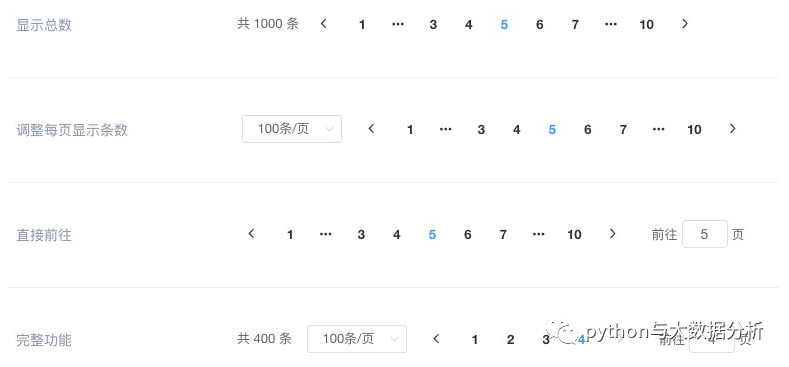关于flask的分页,大家都知道有一个Flask-SQLAlchemy提供的paginate()方法,这个方法配合bootstrap简化了分页连接代码的生成,但其实关于分页数据的返回才是最重要和最难的,数据的生成由多种方法,有原生SQL,有Flask-SQLAlchemy中的原生SQL,有Flask-SQLAlchemy对象数据等等。如何结合数据生成方式和分页组件也算是一个难点吧。
不喜欢ORM的同学,尤其如我,更喜欢写原生SQL多一些,SQL和ORM各有利弊吧。
paginate()方法的返回值是一个Pagination类对象,这个类包含很多的属性,可以用来在模板中生成分页的链接,因此可以将其作为参数传入模板。
Pagination类对象的属性主要有:
has_next:如果在目前页后至少还有一页的话,返回 True。
has_prev:如果在目前页之前至少还有一页的话,返回 True。
next_num:下一页的页面数。
prev_num:前一页的页面数。
另外还有如下的可调用方法:
iter_pages():一个迭代器,返回一个在分页导航中显示的页数列表。
prev():上一页的分页对象。
next():下一页的分页对象。
下面是个标准的分页页面
<!DOCTYPE html>
<html lang="en">
<head>
<meta charset="UTF-8" />
<title>Twitter Bootstrap Tutorial - A responsive layout tutorial</title>
<link href="/static/css/bootstrap.min.css" rel="stylesheet">
<link href="/static/font-awesome/css/font-awesome.css" rel="stylesheet">
<link href="/static/css/animate.css" rel="stylesheet">
<link href="/static/css/style.css" rel="stylesheet">
<link href="/static/css/metisMenu.css" rel="stylesheet">
<link href="/static/css/iconfont/iconfont.css" rel="stylesheet">
</head>
<body>
<table class="table table-bordered text-center">
<thead>
<tr>
<th class="text-center">ID</th>
<th class="text-center">姓名</th>
<th class="text-center">性别</th>
<th class="text-center">职位</th>
<th class="text-center">联系方式</th>
<th class="text-center">操作</th>
</tr>
</thead>
<tbody>
{% for user in pagedata %}
<tr>
<td>{{ user.userid }}</td>
<td>{{ user.username }}</td>
<td>{{ user.sex }}</td>
<td>{{ user.postcard }}</td>
<td>{{ user.phone }}</td>
<td>
</td>
</tr>
{% endfor %}
</tbody>
</table>
{{ pagination.links }}
<script src="/static/js/inspinia.js"></script>
<script src="/static/js/jquery.js"></script>
<script src="/static/js/bootstrap.min.js"></script>
</body>
</html>下面是原生SQL和分页组件的结合,原生数据的输出需要转换为字典类型。
# 用户信息主页面
@app.route('/test/', defaults={'page': 1})
@app.route('/test/<page>')
def list_of_users(page):
page = request.args.get(get_page_parameter(), type=int, default=int(page))
import sqlite3
database = 'C:\Python\Pycharm\supermarket\test.db'
conn = sqlite3.connect(database)
cur = conn.cursor()
cur.execute("select username,password,personalname,birthday,sex,phone,postcard,address from userinfo ORDER BY userid ASC LIMIT {limit} offset {offset}".format(limit=5, offset = (5 * int(page)-5)))
data = [dict(((cur.description[i][0]), value)
for i, value in enumerate(row)) for row in cur.fetchall()]
print("data=", data)
pagination = Pagination(page=page, total=12,per_page=5)
return render_template('fenye.html', pagedata = data, pagination=pagination)下面是db.session.execute和分页组件的组合
# 用户信息主页面
@app.route('/test2/', defaults={'page': 1})
@app.route('/test2/<page>')
def list_of_users2(page):
# sql主体语句
sqlpart="select username,password,personalname,birthday,sex,phone,postcard,address from userinfo "
# where主体语句
wherepart = " where 1=1 "
# order by 主体语句
orderbypart=" ORDER BY userid ASC "
# 分页语句
limitpart=" LIMIT {limit} offset {offset} "
# 每页记录行数暂时内定5
limit=5
# 获取当前页码
page = request.args.get(get_page_parameter(), type=int, default=int(page))
# 判断当前行和偏移量
offset=(5 * int(page)-5)
# 把sql主体语句和where主体语句的SQL合并起来,获取总页数
sqlcount = "select count(*) from ( "+ sqlpart + wherepart+" )"
total = db.session.execute(sqlcount).fetchone()[0]
# 把sql主体语句+where主体语句+order by 主体语句+分页语句合并起来,获取当前页的SQL语句
sql = sqlpart + wherepart + orderbypart + limitpart
sql=sql.format(limit=limit, offset=offset)
# 获取执行结果
data=db.session.execute(sql).all()
# 获取分页代码
pagination = Pagination(page=page, total=total, per_page=5)
# 将数据和分页代码传给页面
return render_template('fenye.html', pagedata=data, pagination=pagination)下面是db.session.query和分页组件的组合
# 用户信息主页面
@app.route('/test3/', defaults={'page': 1})
@app.route('/test3/<page>')
def list_of_users3(page):
page = request.args.get(get_page_parameter(), type=int, default=int(page))
pagination=db.session.query(UserInfo.username, UserInfo.password, UserInfo.personalname,UserInfo.birthday,
UserInfo.sex,UserInfo.phone, UserInfo.postcard, UserInfo.address).order_by(UserInfo.userid.desc()).
paginate(page=page, per_page=5, error_out=True)
items = pagination.items
total = pagination.total
pagination = Pagination(page=page, total=total, per_page=5)
print('pagination=', pagination)
print('pagination.page=',pagination.page) #当前页数
print('pagination.pages=',pagination.pages) #总页数
print('pagination.total=',pagination.total) #数据总条数
print('pagination.has_prev=',pagination.has_prev) #是否存在上一页 返回布尔值
print('pagination.has_next=',pagination.has_next) #是否存在下一页 返回布尔值
return render_template('fenye.html', pagedata=items, pagination=pagination)下面是数据对象和分页组件的结合
# -------------------------用户信息管理------------------------
# 用户信息主页面
@app.route('/test4/', defaults={'page': 1})
@app.route('/test4/<page>')
def list_of_users4(page):
page = request.args.get(get_page_parameter(), type=int, default=int(page))
paginate = UserInfo.query.order_by('userid').paginate(page=page, per_page=5, error_out=False)
pagedata = paginate.items # 当前页数的记录列表
total = paginate.total
pagination = Pagination(page=page, total=total, per_page=5)
if pagedata:
return render_template('fenye.html', pagination=pagination, pagedata=pagedata)
else:
return render_template('404.html'), 404数据生成的方式不同,部分数据生成方式需要再次转换,pagination的使用方式是一致的,但pagedata是不同的,需要关注。

最后
以上就是落后篮球最近收集整理的关于关于flask入门教程-分页的几种方式的全部内容,更多相关关于flask入门教程-分页内容请搜索靠谱客的其他文章。








发表评论 取消回复